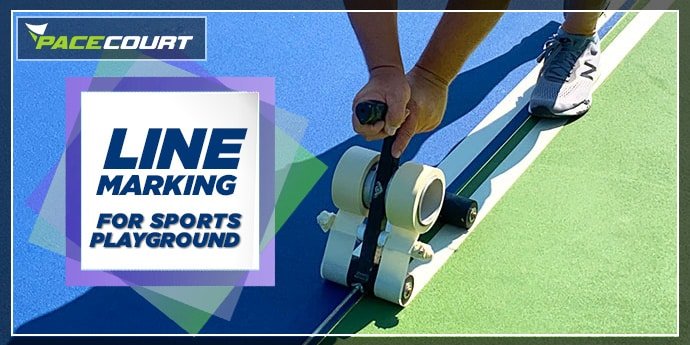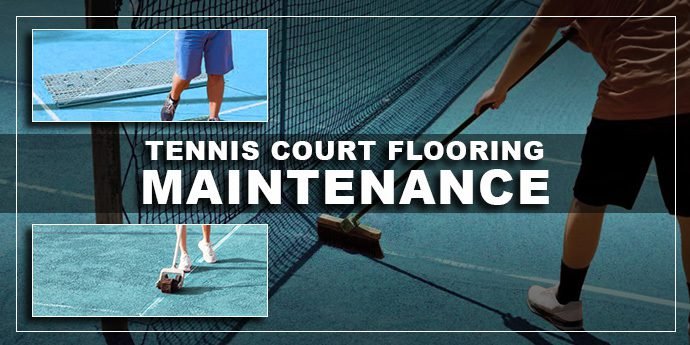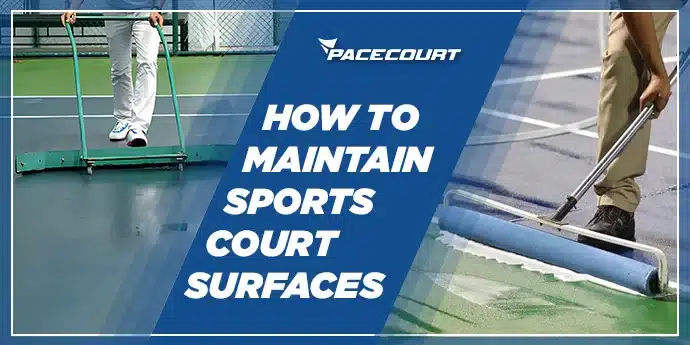Introduction
One of the sports that is most appreciated for its elegance and precision is tennis, where it is vital to define the playing area. The lines on the tennis court for boundaries, services, and other purposes are not only arbitrary markers; rather, they are fundamental components that comprise the court's laws and design. Both amateur and professional players should pay attention to these lines. In this piece, we'll argue for outdoor surfaces—especially those composed of acrylic flooring—and explain why tennis courts need to have their lines drawn out. Additionally, a few case studies demonstrate how maintaining these marks has improved players' games.
The Role of Line Markings in Tennis
The line markings of a tennis court perform numerous important functions. They indicate the limits of the playing area, indicate the service boxes, and help players comprehend the complex rules of the game. Here are some reasons why these markings are indispensable:
- Defining the Play Area: Clearly, the primary purpose of line markings on sports fields is setting limits for the court. This enables both players and referees to know with absolute certainty if a ball is within or outside. In professional games, line markings determine winning or losing outcomes.
- Guiding Player Movement:Line markings similarly lead athletes in their motion, assisting them to stand appropriately for serves and volleys. Illustratively, the baseline services lines and center mark play eminent roles in player placement and tactics.
- Ensuring Fair Play:To ensure the game is fair, it is important that there are clear and precise markings. Markings provide a visual reference for players, referees, and spectators alike, thereby ensuring that everyone can easily comprehend how that game is going.
- Enhancing Safety: Appropriately labeled lines will help prevent accidents by clearly reporting the play area. This is very important in doubles matches, where players have to focus on their surroundings to avoid bumping against each other.
The Importance of Using Synthetic Flooring for Tennis Courts
When it comes to outdoor tennis courts, the choice of flooring material can significantly impact the quality of the playing experience. Synthetic flooring, particularly acrylic, offers several advantages:
- Durability: What describes them best is the ability to endure and their resistance toward changes in weather. Therefore, the recommended use of these specific materials for courts that are always outside is a good idea. They can endure ultraviolet rays, rainfall, and heat variations without falling apart.
- Performance:Out of all the different types of flooring for indoor sports, acrylic flooring is the one that offers uniform playing surfaces with high ball rebound and anti-slip properties. Factors such as these make it possible for both novice and experienced players to excel in their respective games.
- Aesthetic Appeal: One can choose from different hues when it comes to acrylic surfaces, which enable the facilities to make their courts look like they wish them to look, making them very attractive visually as well as enhancing the degree of visibility both for players and spectators.
- Low Maintenance: An acrylic tennis court is simple to maintain and cheap to maintain. The surface can often be kept in good condition just by using water and some mild detergents. On top of that, acrylic flooring does not require resurfacing as often as other materials when it comes to durability.
- Eco-Friendly: Acrylic floor systems are made with water as their main ingredient and have a small amount of volatile organic compounds (VOCs), which makes those systems considered eco-friendly. These kinds of floors are beneficial because they do not cause harm to people who install them or play on them and also last long, hence one would rarely want to replace them, cutting down on dumps.
The Significance of Precision in Line Markings
When it comes to the dimensions of a tennis court, precision in the marking may seem like an issue that is merely cosmetic; however, for players, it is more than just that. Unaligned and worn-out lines can result in arguments, misunderstandings, and occasionally, accidents. Below are reasons why precision is important:
- Accuracy in Gameplay: Lines have to be correctly placed in order for the game to be accurate. A single deviation from what is specified can sway players’ decisions, thereby determining the outcome of the match. The service line's position is, for example, so critical that it determines whether or not a serve will count, which affects the whole game.
- Player Confidence: Clear and unambiguous boundaries foster confidence in athletes, allowing them to focus on their game rather than worrying about their own incapacity to discern boundaries. This is a critical component for competitive venues since accuracy is paramount in these settings.
- Aesthetic Quality: The court has an aesthetic quality that is greatly contributed to by the distinctly marked lines. They give the place an air of professionalism, something important to both local clubs and big tournaments.

Case Studies
Case Study: Upgrading a Community Tennis Court
A real case study highlighting the advantages of proper line markings and synthetic flooring is discussed below. A community park in an emerging town opted to reconstruct its old tennis court. The old surface had faded lines and cracks that made playing uninteresting at times. Therefore, park management decided on new acrylic surfaces with properly defined line markings.
Project Overview:
- Location: Urban Community Park
- Project Scope: Tennis court resurfacing and line marking
- Material Used: Acrylic synthetic flooring
- Duration: 3 weeks
The Process: The first stages of this project involved removing existing surface layers and addressing any structural issues. The following step involved applying a fresh coat of smooth acrylic top coat, which is supposed to endure for a long time. This also meant that in order to make lines stand out immediately and remain visually appealing for a considerable amount of time, black colors had to be used to mark them.
Results: The neighborhood tennis players have been swarming the court since it was renovated. Its bright and clear ground markings make it easy for players to comprehend how they should play. The game is more fun than it has ever been because of the surface's dependability and smoothness, which enable excellent ball control. Positive reports suggest that the park's investment in a costly outdoor sports facility has pleased the locals.
Case Study: Transforming a School’s Sports Facilities
One more instance is related to a school that made a decision to improve its sports infrastructure, including tennis courts. The primary objective was to put in place a modern sports facility for the benefit of the students while attracting some local competitions. Decision makers resolved on an acrylic surface with more elaborate markings.
Project Overview:
- Location: School Campus
- Project Scope: Tennis court installation and line marking
- Material Used: Acrylic synthetic flooring
- Duration: 4 weeks
The Process: There was a removal of the old courts, and leveling of the ground was done. A high-quality acrylic surface was then installed, followed by precise line markings. The school selected a color scheme that enhanced visibility and complemented the campus's overall design.
Results: Students found the new courts to be an excellent ground to familiarize themselves with, and local sporting bodies were drawn towards them. With well-defined boundary lines, students were assured of learning and practicing their game with a lot of ease. The school has also seen tennis participation rise, emphasizing the benefits that come with having good-quality sports facilities.
The Future of Tennis Court Design and Sustainability
Synthetic floorings, such as acrylic, may become more and more common with the increasing demand for green sports structures. Moreover, it is difficult to find any other materials that can match their blend of performance, durability, and environmental friendliness. Furthermore, the quality of these surfaces is continuously being enhanced through technological improvements that heighten their lifespan, hence making them appealing for sports complexes.
It is imperative that line markings be done correctly, and this cannot be overstated. They are an essential component of the design of the court that affects how much fun a game is overall. Because of this, tennis courts all over the world need to keep spending money on high-quality supplies and precise line marking techniques in order to maintain their aesthetic appeal and standards as time goes on.
Expert Guidance for Your Sports Project
For any further queries and clarifications, you can get in touch with us

Conclusion: The Essential Nature of Line Markings in Tennis Courts
In summary, line marking is fundamental to the structure and fairness of tennis; it is not merely a formality. They serve as a boundary marker, aid in player movement guidance, and guarantee that all games are performed in accordance with these established regulations. High-quality synthetic surfaces, like acrylic, have the advantage of being long-lasting, secure, and environmentally benign.
The case studies that are being presented demonstrate the transforming power of appropriate synthetic surfaces and line markings on tennis courts. These characteristics increase playability and encourage more people to visit towns, parks, and educational institutions.
When it comes to facility proprietors, putting money into precise line markings and premium surfaces amounts to putting money into their sports activities’ future. Notably, clothing like Pacecourt, at the forefront of delivering quality synthetic flooring solutions, inspires hopes for sustainable and environmentally-friendly tennis court designs.
Answer: This ensures that the topcoat stays in place and performs well over time. Additionally, it creates a smooth, even base that helps achieve a uniform and high-quality finish.
Synthetic acrylic flooring is indeed customizable. Coming in many colors and finishes, you can create a court that captures your style, team colours or brand. It is available in a wide spectrum of colors and finishes which allows for a court design that reflects individual styles, team colours or brand identity. This may take in logos, mascots and aesthetic line markings for a unique look. Consequently, this kind of customization enhances both the appeal of its looks and how it can effectively used as intended.






